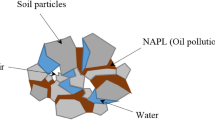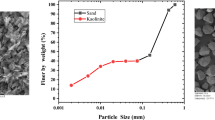Abstract
An oil leakage can result due to particular events such as tanker accident, pipeline corrosion, and natural and manmade disasters. This paper reports on the first phase of a research program to investigate the effects of oil on the geotechnical properties of laterite soils with silty sand (SM) and silty clay (SC) classifications. The Atterberg limits, compaction, direct shear, unsoaked CBR, and permeability tests were carried out on clean and oil-contaminated laterite soil samples, and the changes to the properties were evaluated. Through XRD and XRF analysis, the mineral and chemical compositions of the laterite soils were determined. To simulate the oil-contaminated soil samples, the laterite soils were mixed with heavy motor oil at 3%, 5%, 8%, and 10% oil contents by dry weight of a specimen. The results show that with an increase in oil content, significant decreases in optimum fluid content, liquid limit, plastic limit, bulk unit weight, permeability, friction angle, and cohesion were realized. The cohesion in SM laterite soils however increased slightly due to the contamination. Some findings are totally consistent with some studies, partially consistent, and inconsistent with some other studies, however, all of these studies neither described how the fluid content and oil–water evaporation rate could be measured in the oven-drying process, nor how the fluid content and oil–water evaporation rate could be used in the equations, which this paper attempts to address. Awareness of the effects of oil-contamination should be crucial in environmental and coastal engineering undertakings and should help in providing the most effective techniques for stabilization.














Similar content being viewed by others
Abbreviations
- OC:
-
Oil content
- ϕ :
-
Angle of internal friction
- c :
-
Cohesion
- D10 :
-
Grain size at 10% passing
- D50 :
-
Grain size at 50% passing
- C u :
-
Uniformity coefficient
- C c :
-
Curvature coefficient
- W w :
-
Water content of oil-contaminated sand
- m :
-
Weight of residual oil after drying
- n :
-
Weight of residual oil before drying
- W t :
-
Oil-contaminated soil weight before drying
- W r :
-
Oil-contaminated soil weight after drying
- \(\gamma\) :
-
Coefficient of oil drying loss
- W o :
-
Oil loss due to drying
- k s :
-
Sub-grade reaction modulus
- k :
-
Coefficient of permeability
References
Al-Duwaisan DB, Al-Naseem AA (2011) Characterization of oil contaminated soil-Kuwait oil lakes. In: Proceedings of international conference on environmental science and technology (ICEST 2011)
Al-Sanad HA, Eid WK, Ismael NF (1995) Geotechnical properties of oil-contaminated Kuwaiti sand. J Geotech Eng 121:407–412
Balena R (2015) Priority responses to the 2006 Guimaras oil spill, Philippines: Will history repeat itself? J Ocean Coast Manag 103:42–55
Evgin E, Das B (1992) Mechanical behavior of an oil contaminated sand. Environmental Geotechnology, Usmen & Acar, Balkema, Rotterdam
Fingas M (2016) Oil spill science and technology, Gulf professional publishing
George S, Aswathy E, Sabu B, Krishnaprabha N, George M (2015) Stabilization of diesel oil contaminated soil using fly ash. Int J Civ Struct Eng Res 2
Gidigasu M (2012) Laterite soil engineering: pedogenesis and engineering principles. Elsevier
Huang F, Lu H (2014) Experiment study on the atterberg limits of clay contaminated by oil. Electron J Geotech Eng 19:3037–3046
Ijimdiya TS (2012) Effect of oil contamination on particle size distribution and plasticity characteristics of lateritic soil. Adv Mater Res. Trans Tech Publ, 19–25
Imevbore V, Imevbore A, Gundlach E (1997) Niger delta environmental survey 1997, Vol 1 - Environmental and Socio-Economic Characteristics
Jia Y, Wu Q, Shang H, Yang ZN, Shan H (2011) The influence of oil contamination on the geotechnical properties of coastal sediments in the Yellow River Delta, China. J Bull Eng Geol Environ 70:517–525
Kadafa AA (2012) Oil exploration and spillage in the Niger Delta of Nigeria. J Civ Environ Res 2:38–51
Kampa AL, Casarotto T, Maria A, Woodard-Wallace CG, Whyte JS (2014) Documentation and analysis of the Rayong oil spill: characterizing the health, economic, and social impacts of the incident and response
Kermani M, Ebadi T (2012) The effect of oil contamination on the geotechnical properties of fine-grained soils. Soil Sedim Contam Int J 21:655–671
Khamehchiyan M, Charkhabi AH, Tajik M (2007) Effects of crude oil contamination on geotechnical properties of clayey and sandy soils. J Eng Geol 89:220–229
Khosravi E, Ghasemzadeh H, Sabour MR, Yazdani H (2013) Geotechnical properties of gas oil-contaminated kaolinite. J Eng Geol 166:11–16
Mahalinga-Iyer U, Williams DJ (1997) Properties and performance of lateritic soil in road pavements. J Eng Geol 46:71–80
Manning FS, Thompson RE (1995) Oilfield processing of petroleum: crude oil. Pennwell Books
Meegoda JN, Chen B, Gunasekera SD, Pederson P (1998) Compaction characteristics of contaminated soils: reuse as a road base material. J Geotech Spec Publ 195–209
Meegoda NJ, Ratnaweera P (1994) Compressibility of contaminated fine-grained soils. Geotech Test J 17:101–112
Moore C, Mitchell J (1974) Electromagnetic forces and soil strength. J Geotechnique 24:627–640
Nasr AM (2014) Utilisation of oil-contaminated sand stabilised with cement kiln dust in the construction of rural roads. J Int J Pav Eng 15:889–905
Nazir AK (2011) Effect of motor oil contamination on geotechnical properties of over consolidated clay. Alex Eng J 50:331–335
Obeta I, Eze-Uzomaka O (2013) Geotechnical properties of waste engine oil contaminated laterites. Niger J Technol 32:203–210
Obot E, Antonio Q, Braide S, Dore M, Wicks C, Steiner R (2006) Niger delta natural resource damage assessment and restoration project. J Report submitted to the Federal Ministry of Environment, Abuja Nigeria Conservation Foundation, Lagos
Olson RE, Mesri G (1970) Mechanisms controlling compressibility of clays. J Soil Mech Found Div 96
Oluremi J, Adewuyi A, Sanni A (2015) Compaction characteristics of oil contaminated residual soil. J Eng Technol 6:75–87
Onyelowe KC (2015) Pure crude oil contamination on Amaoba lateritic soil. J EJGE 20
Oyegbile OB, Ayininuola GM (2013) Laboratory studies on the influence of crude oil spillage on lateritic soil shear strength: a case study of niger delta area of Nigeria. J Earth Sci Geotech Eng 3:73–83
Oyelami C, van Rooy JL (2016) Geotechnical characterisation of lateritic soils from south-western Nigeria as materials for cost-effective and energy-efficient building bricks. Environ Earth Sci 75:1475
Patel A (2011) Study of Geotechnical properties of black cotton soil contaminated by castor oil and stabilization of contaminated soil by sawdust. In: National conference on recent trends in engineering & technology, pp 13–14
Persons, B. S. 1970. Laterite: genesis, location, use, Springer Science & Business Media.
Polidori E (2007) Relationship between the Atterberg limits and clay content. J Soils Found 47:887–896
Puri VK (2000) Geotechnical aspects of oil-contaminated sands. J Soil Sediment Contam 9:359–374
Putri EE, Rao N, Mannan M (2012) Evaluation of modulus of elasticity and modulus of subgrade reaction of soils using CBR test. J Civ Eng Res 2:34–40
Rahman ZA, Hamzah U, Taha MR, Ithnain NS, Ahmad N (2010) Influence of oil contamination on geotechnical properties of basaltic residual soil. Am J Appl Sci 7:954
Ratnaweera P, Meegoda JN (2005) Shear strength and stress-strain behavior of contaminated soils. Geotech Test J 29:133–140
Rusli MHM (2012) Navigational hazards in international maritime chokepoints: a study of the Straits of Malacca and Singapore. J Int Stud 8:1–35
Saberian M, Khabiri MM (2018) Effect of oil pollution on function of sandy soils in protected deserts and investigation of their improvement guidelines (case study: Kalmand area, Iran). J Enviro Geochem Health 40:243–254
Sadeeq J, Ochepo J, Salahudeen A (2014) Effect of used oil contamination on the volumetric shrinkage of lateritic soils. In: Proceedings of the third international conference on engineering and technology research, Ladoke Akintola University of Technology, Ogbomoso, Nigeria, 2014, pp 167–175
Shah SJ, Shroff A, Patel JV, Tiwari K, Ramakrishnan D (2003) Stabilization of fuel oil contaminated soil—a case study. J Geotech Geol Eng 21:415–427
Shin E, Lee J, Das B (1999) Bearing capacity of a model scale footing on crude oil-contaminated sand. J Geotech Geol Eng 17:123–132
Spagnoli G, Fernandez-Steeger T, Feinendegen M, Stanjek H, Azzam R (2010) The influence of the dielectric constant and electrolyte concentration of the pore fluids on the undrained shear strength of smectite. J Soils Found 50:757–763
Sridharan A, Raot GV (1973) Méchanisms controlling volume change of saturated clays and the role of the efiective stress concept. J Géotechm’que 23:359–382
Sukhadane KS, Priya E, Raut SM, Jayakumar T (2013) Status of oil pollution in Indian coastal waters. J Fishing Chimes 33:53–54
Sunil B, Shrihari S, Nayak S (2009) Shear strength characteristics and chemical characteristics of leachate-contaminated lateritic soil. J Eng Geol 106:20–25
Tardy Y (1997) Petrology of laterites and tropical soils, AA Balkema
Ur-Rehman H, Abduljauwad SN, Akram T (2007) Geotechnical behavior of oil-contaminated fine-grained soils. Electron J Geotech Eng 12
Wang J, Wu L, Feng R (2017) An experimental case study of a high-liquid-limit lateritic soil with its application in road construction. J Road Mater Pavement Des 18:1423–1433
Winterkorn HF, Pamukcu S (1991) Soil stabilization and grouting. Foundation engineering book. Springer, Berlin
Zheng X, Zhang J, Zheng T, Liang C, Wang H (2014) A developed technique for measuring water content in oil-contaminated porous media. J Environ Earth Sci 71:1349–1356
Acknowledgements
The authors wish to express sincere appreciation for the support from Universiti Sains Malaysia in making this project a success. The research was funded by the Department of Higher Education, Ministry of Education Malaysia under the Fundamental Research Grant Scheme with Grant Number FRGS/1/2018/TK01/USM/03/4.
Author information
Authors and Affiliations
Corresponding author
Ethics declarations
Conflict of interest
The authors wish to confirm that there are no known conflicts of interest associated with this publication and there has been no significant financial support for this work that could have influenced its outcome.
Rights and permissions
Springer Nature or its licensor holds exclusive rights to this article under a publishing agreement with the author(s) or other rightsholder(s); author self-archiving of the accepted manuscript version of this article is solely governed by the terms of such publishing agreement and applicable law.
About this article
Cite this article
Abdelhalim, R.A., Ramli, H. & Selamat, M.R. Investigating the impacts of oil contamination on geotechnical properties of laterite soils. Innov. Infrastruct. Solut. 7, 321 (2022). https://doi.org/10.1007/s41062-022-00901-0
Received:
Accepted:
Published:
DOI: https://doi.org/10.1007/s41062-022-00901-0




